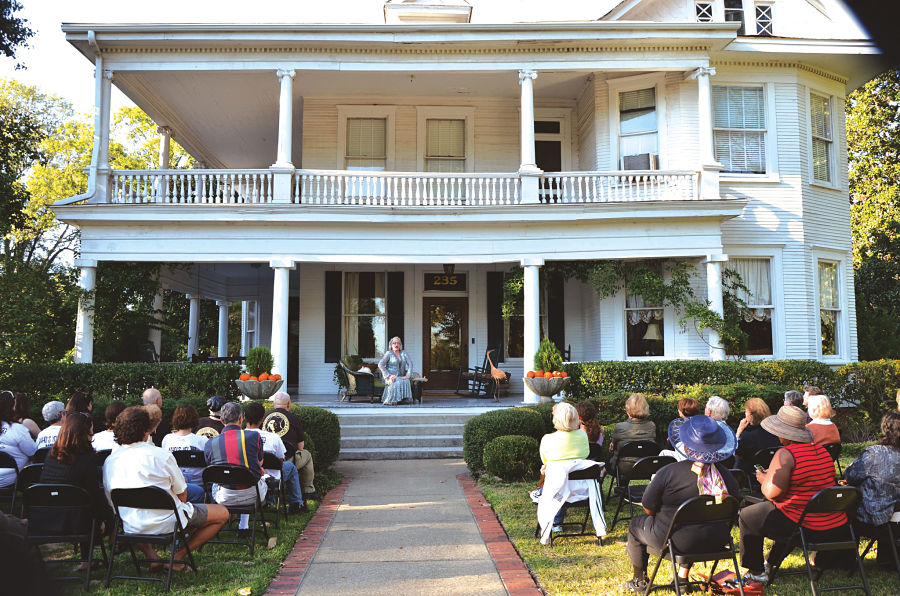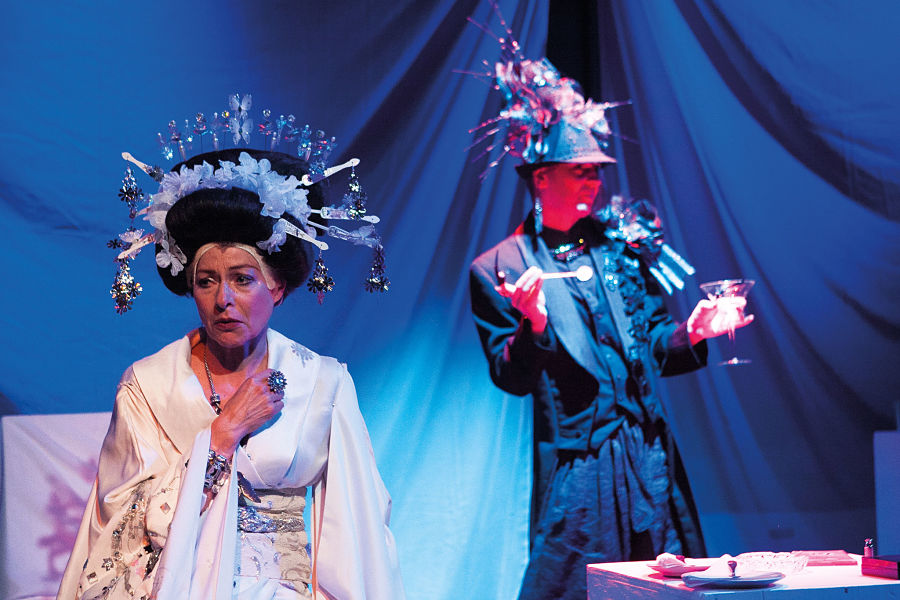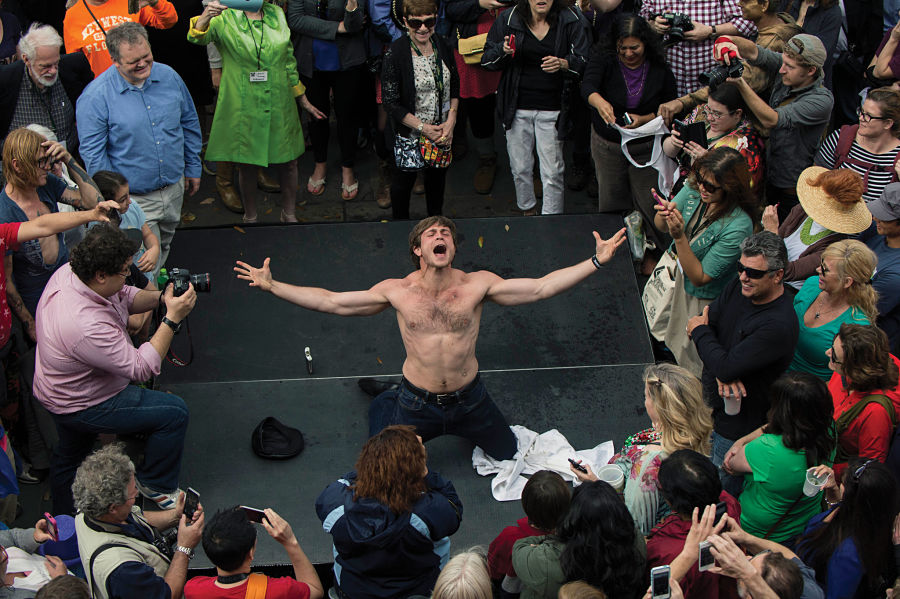“Stella!!” the first performer yelled.
“Stella!!!” he repeated, more dramatically.
“STELLAAAAAA!!!!!!” he shouted yet again, desperately, as he crouched down on a makeshift stage on New Orleans’ Jackson Square and ripped open his shirt.
The next contestant also ripped open his shirt. So did Contestant 4 (dousing himself first with water), Contestant 18 (a young woman), and Contestant 20 (an older man). But there was surprising variety in the shouting at this last of some 50 events that made up the 29th annual Tennessee Williams/New Orleans Literary Festival in March. Beneath a balcony graced with one of the city’s characteristic wrought-iron railings, a parade of Stella-yellers beseeched their estranged wife (played by festival board president Janet Daley Duval), who peered down at them in a black negligée, wielding a microphone.
Duval-as-Stella’s comments alternatively encouraged or mocked such contenders as a busker painted all in gold; an entire family who screamed after inhaling from helium-filled balloons; a middle-aged man delivering a monologue full of shrugs and Yiddishisms; and a woman who flailed on the ground as if having an epileptic seizure.
The judges—including veteran Williams performer Keir Dullea (who played Brick in Cat on a Hot Tin Roof’s 1974 Broadway staging) and his wife, the actress Mia Dillon—disappeared from the balcony to deliberate, then returned with the winner: Daphne Britton, who had grabbed the sides of her face with both hands and squeezed as if truly upset, and then, her hands functioning as a megaphone, let out a shout that parted the ions in the air.
“I’m a big Tennessee Williams fan,” effused the victorious Britton, who majored in English literature as an undergraduate and is now a graduate student in education. But this was the only one of the festival events in which she participated—or has ever participated in: “I don’t have the time. I have homework. I don’t get out much.”
If the Stella shouting match, which became an annual event in 1996, has not quite reached the status of the running of the bulls in Pamplona, Spain, among lovers of American literary lore, it’s part of a phenomenon that not even all Williams fans know about: the proliferation of annual Tennessee Williams festivals across the country. There are a total of five in the South and the Northeast, one about to mark a major anniversary. A sixth has scheduled its debut in the Midwest next year.
“Each serves its own purpose,” says Kenneth Holditch, who helped start three of them.
On a second-floor parlor of the Hotel Monteleone, an officially designated literary landmark where Williams liked to stay (and the official headquarters for the New Orleans festival), Holditch was holding forth on his friendship with Tennessee Williams. “I was fortunate to get to know him in the late 1970s,” he began.
“Two environments provide inspiration for most of his best work—Mississippi and New Orleans,” suggested Holditch, who himself grew up in Mississippi and now lives in New Orleans, where he taught literature for many years. His adopted city, he pointed out, is the setting for A Streetcar Named Desire, Suddenly, Last Summer, Vieux Carré and “the one-act plays.”
Holditch has written several books about Williams (with Mel Gussow, he edited the two-volume Library of America edition of Williams’s plays) and you can see his name throughout the French Quarter, at the bottom of plaques and posters on Williams landmarks (where the celebrated writer lived, where he ate, where he drank) for which Holditch wrote the text. His lecture about Williams at the Hotel Monteleone served as an introduction to the walking tour of Williams landmarks that Holditch’s tour company conducts.
The New Orleans celebration began, as he recounts it, when “a group of people decided over dinner one night that there should be a festival in New Orleans to honor something other than sports and food.” In 1986, three years after Williams’s death, the Tennessee Williams/New Orleans Literary Festival was officially launched, and it remains the oldest and largest of the festivals. For its 25th anniversary (also Williams’s centennial), attendance reportedly exceeded 10,000.

Seven years after the start of the New Orleans festival, Panny Mayfield co-launched the Mississippi Delta Tennessee Williams Festival, held every fall in Clarksdale, Miss.
A photographer and journalist, Mayfield had been invited to give a presentation at an International Tennessee Williams Conference in Nantes, France, and she was encouraged by the scholars and directors there to start an annual festival in her town. Mayfield has written about the links between Williams and the town where he spent much of his childhood. “When we began in 1993, there were residents here who grew up with Tom Williams,” Mayfield says. “His grandfather, the Rev. Walter Dakin, was the popular rector of St. George’s Episcopal Church for 16 years. Tom, his mother and his sister Rose lived in the church rectory here with his grandparents, while Cornelius Williams [his father] worked as a traveling shoe salesman.”
Two years after its launch, “The U.S. Postal Service selected our festival as its site to unveil the Tennessee Williams postage stamp—the ceremony took place on the front porch of a turn-of-the-19th-century house in Clarksdale’s historic district, where Tom Williams spent his childhood,” Mayfield recounts. Porches play a continuing role in the festival, which this year will be held on Oct. 2 and 3, and will once again feature “porch plays” in four locations in the district.
Brenda Caradine, a former actress who now runs a local bed and breakfast, was the driving force behind the Tennessee Williams Tribute & Tour of Victorian Homes in Columbus, Miss., which began in 2001. “When I moved to Columbus 18 years ago, there was no festival,” says Caradine with an air of shock filtered through high-energy Southern charm. “Columbus was Williams’s birthplace! He was baptized in my church!” Among the activities at the Columbus festival, to be held this year Sept. 6¬13, is another Stella shouting contest.
But the three festivals in the South, says Holditch (who was an advisor for all of them), have for the most part developed distinct identities: “New Orleans has expanded to cover all sorts of aspects of the city’s history and culture,” he allows, along with a scholars conference and master classes on writing. Only nine of this year’s events, or less than a fifth of the five-day festival, were labeled “theatre offerings,” and only three of these were full productions or staged readings of complete Williams plays.
“Columbus tends to be more social, with parties and tours of Victorian homes,” Holditch says, “and Clarksdale is more devoted to scholarship and history and the relationship between Tennessee’s work and the Delta.”

It was in 2006 that a fourth festival was added to the mix, the Provincetown Tennessee Williams Theater Festival. As co-founder and curator David Kaplan explains it, the fabled Massachusetts seaside town was finally going to build a new theatre—the landmark Provincetown Playhouse had burned down in 1977—and it wanted an annual festival to promote the venue. “Tennessee Williams was the fourth idea” for a festival subject, says Kaplan. Still, if Williams was not the first choice, the playwright’s life and work held genuine interest.
Kaplan, a director who has helmed Williams productions as far away as Russia and Hong Kong, published Tennessee Williams in Provincetown in 2007, chronicling the four summers Williams spent in the resort town in the 1940s, the two plays he set there (Something Cloudy, Something Clear and The Parade, or Approaching the End of a Summer), and the additional plays he worked on there. Research for the book included, Kaplan notes, an interview with “the woman who lent him the typewriter on which he wrote The Glass Menagerie.”
The Provincetown organizers boast that theirs is the only one of the Williams events that is strictly a theatre festival (although it defines theatre rather broadly to include “dance, music, opera, film and performance art”). The four-day event attracts some 1,800 theatregoers. This year’s 10th-anniversary festival, slated Sept. 24–27 and entitled “Year TENN: A Decade of Tennessee Williams in Provincetown,” will offer 10 productions, including the remounting of hits from previous years, such as a South African production of The Milk Train Doesn’t Stop Here Anymore, and a new musical from London, The Liberation of Colette Simple, based on a play Williams wrote in 1941, The Case of the Crushed Petunias, which the festival presented in 2009.
For the past three years, in May or June, there also has been an annual Tennessee Williams Festival in New York City. “We always felt that it was sort of a disservice to one of our great dramatists that there was no festival for Tennessee Williams in the capital of the theatre world,” says Joseph W. Rodriguez, producing artistic director of the six-year-old Playhouse Creatures Theatre Company, the Village–based sponsor of the festival, which has thus far drawn an audience of a couple hundred people to staged readings of Williams one-acts and panel discussions with directors of Williams’s work (Emily Mann, Austin Pendleton) and with playwrights who admire him (such as Stephen Adly Guirgis).
The first annual Tennessee Williams Festival of St. Louis is scheduled for April 2016. “I have always strongly connected to Williams’s writing and consider him America’s, if not the world’s, greatest playwright,” attests Carrie Houk, who is organizing the Missouri festival. A casting director and former actress, Houk met Williams once (“I had the pleasure of dancing with him and talking about the hometown”). St. Louis is, of course, the setting for his first success, The Glass Menagerie, but it was an earlier, more obscure Williams play that spurred Houk to action. Stairs to the Roof, subtitled A Prayer for the Wild of Heart That Are Kept in Cages, is set largely in a shirt factory in St. Louis, and focuses on a poetry-writing worker who seeks to escape his dead-end job.
In conjunction with her production of the play, hooked to the celebration of the city’s 250th anniversary last year, Houk included both panel discussions and a bus tour of Williams landmarks in St. Louis—his various residences, the shoe factory where he worked, his grave. “I began to see the huge thirst that the city had for his work.”
So why are there so many Tennessee Williams festivals, yet no similar treatment for, say, Eugene O’Neill or Arthur Miller?
A couple of Williams experts hazard a guess: Thomas Keith, a consulting editor at New Directions, Williams’s publisher, is a prolific panel organizer and moderator at several of the festivals: “With 35 full-length plays, over 75 one-act plays as well as stories, poems, essays, screenplays, letters, journals and novels, he left an enormous body of work for performance, exploration and appraisal.”
John Lahr, author of the 2014 biography Tennessee Williams: Mad Pilgrimage of the Flesh, concurs: “I guess the reason for the festivals has to do with the voluminous amount of Williams work and its variety—you can read poems, do scenes and plays, both full and one-act. Then there’s the complex life. He also, in his way, was a pathfinder in gay liberation, so he speaks to the moment as well as the past. His plays act well, which is also a reason to do them. More than O’Neill and Miller, his work was vilified in his lifetime, and the festivals are an attempt to right a great cultural wrong.”
“Death is the only thing that can possibly save my reputation,” the fictional writer declares when a young woman fan finds him wasting away in a seamy boardinghouse. She has discovered his old book of poems in an antique store, placed under the short leg of a little Chinese tea table in order to keep the table balanced. She has tracked him down and now wants to resurrect his career (“I’ve written letters to influential people”). He’ll have none of it.
The scene is from a short play entitled Mister Paradise, which Williams wrote some time after he first visited New Orleans in 1938; it was not published until 2005. It is one of at least a dozen short plays of his that take place in boardinghouses or hotels, four of which were grouped together at the New Orleans festival this year as the Hotel Plays. In another one of the four, The Lady of Larkspur Lotion (c. 1941), a similarly bedraggled writer lashes out at his landlady in order to defend the honor of another boardinghouse resident, a woman who says she is a rubber plantation heiress (but, as the landlady points out mockingly, is actually a prostitute). The landlady ridicules the writer as well for claiming to be the author of a 780-page manuscript. In a tired voice, he replies with a long monologue:
“Suppose there is no 780-page masterpiece in existence….Suppose I wanted to be a great artist but lacked the force and the power!…Suppose that I ornament, illuminate—glorify…with…impending Broadway productions….What satisfaction can it give you, good woman, to tear it to pieces, to crush it—call it a lie?”
There were layers of insight and irony in the production of the Hotel Plays, staged in the Hermann-Grima House, a mansion built in 1831 that is now a French Quarter museum. When audience members lined up to receive their tickets, they were handed room keys to what had been turned into a pretend hotel, with each play performed in a different room.
Although the casts were from New Orleans—the same local actor, Robert Mitchell, portrayed both failed writers—the Hotel Plays were a production of the Provincetown festival, which has presented various selections of these plays over the years. “From the very beginning, I thought it important to have synergy with the other festivals,” Kaplan says. Collaborating on plays in which the playwright is concerned with a writer’s reputation seems especially apt. “The festivals all have a mission of reconsidering his reputation,” Kaplan adds.
Has it worked? What effect has the array of Williams festivals produced?
“We have championed Williams’s entire body of work, but with particular emphasis on his later and more experimental writing,” specifies Jef Hall-Flavin, executive director of the Provincetown festival, which has premiered 10 of the writer’s previously unproduced plays.
“All you heard was that these plays were unperformable, that they didn’t work,” says Kaplan, who believes the main reason for the dismissive attitude was “homophobia, plain and simple.” If the times in general have made audiences more receptive to these dramas, the fests “showed that these plays work as plays.”
New Orleans has a more active theatre scene now than there was before the festival existed, which most observers attribute to the rebuilding that has occurred after Hurricane Katrina. “The Williams festival has not had an effect on theatre in New Orleans so much as the theatrical community has had an effect on the Williams festival,” proposes Jim Fitzmorris, a teacher, critic and director. “It’s turned from a literary festival into a bona fide theatrical event in the last few years, because of the pressure from the new theatre companies.”
The festival atmosphere is celebratory. This year’s featured a “birthday bash” on the day that Williams would have turned 104, at the Queen Anne Ballroom of the Hotel Monteleone. It began with something less than reverence, as an almost-life-sized cardboard cutout of the playwright was propped up in the corner, adorned with Hawaiian leis. A procession of scenes began with a performance of Christopher Durang’s spot-on Williams parody, For Whom the Southern Belle Tolls. Then Keir Dullea and Mia Dillon portrayed Big Daddy and Big Mama in a scene from Cat on a Hot Tin Roof; followed by two scenes from Menagerie, one from Vieux Carré and one from Sweet Bird of Youth.
In the audience were prime movers from all of the festivals—and one of the actors onstage (for the Sweet Bird of Youth scene) was Aimée Hayes, producing artistic director of Southern Rep Theatre, a New Orleans company that has participated in the festival for the past six years, this year with a full production of Suddenly, Last Summer starring Brenda Currin. Hayes, who herself played Blanche DuBois in the company’s 2012 Streetcar, thinks the New Orleans festival “does an amazing job of highlighting recent scholarship, activating conversations and drawing parallels between Tenn’s work and current writers and playwrights.” She sees New Orleans as an exact fit for such a festival: “In a town like New Orleans on the brink of sinking (literally) into the drink and a long history of carpe diem hedonism, Williams’s do-or-die stories resonate deeply as credo and anthem.”
But she also understands why the idea has spread: “Nobody quite gets to the guts of living more than Williams. He always seems to be daring us to live on just a little intuition, lots of desire and the pursuit of beauty. Who cares if death, destruction and utter ruin hound us at every turn? At least we’re really living!”
New York City–based arts journalist Jonathan Mandell writes regularly for this magazine.


